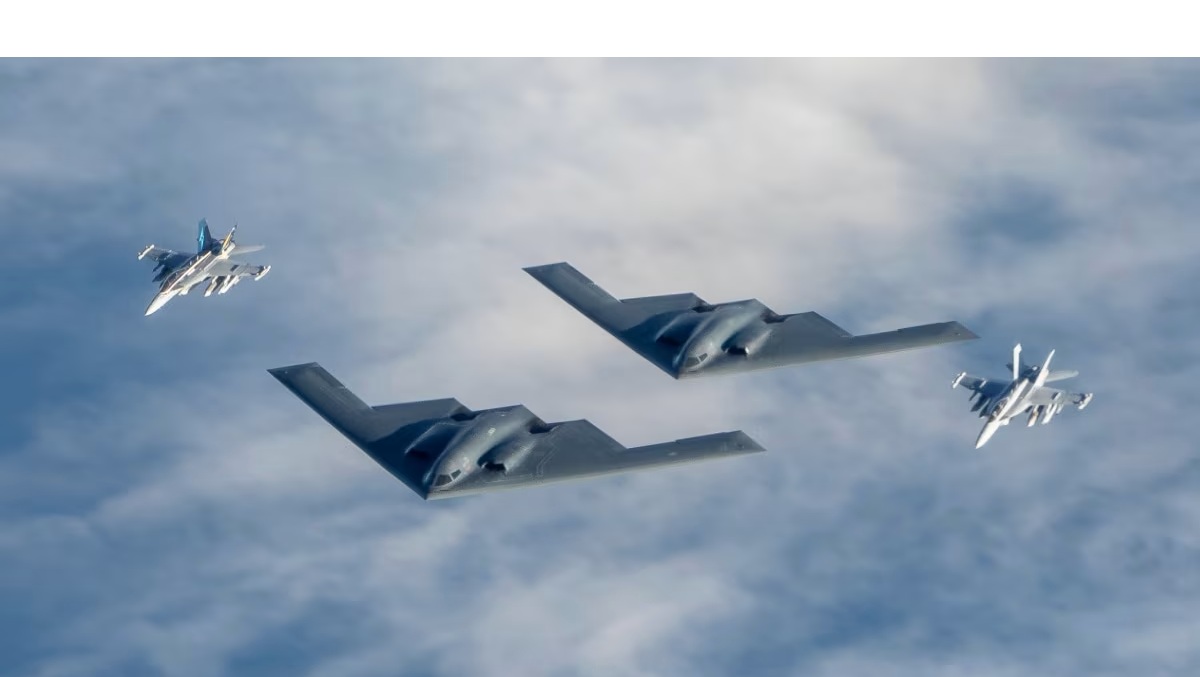U.S. airstrike on Iran’s nuclear facilities on Sunday, June 22, 2025, may have taken a previously unseen route, one that flew directly over Indian airspace.
Regional sources, cited in multiple reports on Sunday, suggest that American B‑2 stealth bombers launched from Guam, crossed the Andaman Sea, traversed central India, and struck Iran after skirting the Arabian Sea.
A Stealth Path Over India
According to flight experts, the bombers, designed for strategic reach—departed from Guam (at approximately 15°N, 145°E), journeyed through the Andaman Sea (10°N, 95°–100°E).
It then entered Indian airspace near central India (20°N, 75°–80°E), before swinging west across the Arabian Sea to strike near Iran’s eastern border (25°–30°N, 60°–65°E).
If verified, this unannounced overflight marks a dramatic shift in India’s strategic posture.
Defense analysts are already treating it as an indicator of India’s willingness to support expanded U.S. military action, a tacit, but powerful, nod to closer strategic alignment.
One regional analyst told local media: “It could mark a new chapter in the regional security calculus.”
However, neither India nor the U.S. military has officially confirmed the use of Indian airspace, leaving open questions about Indian government complicity or mere acquiescence.
Operation Midnight: A Bold U.S. Declaration
On June 21, President Trump revealed that the U.S. had targeted Iran’s three main nuclear facilities in a massive strike he dubbed “Operation Midnight.” The campaign reportedly involved:
Fourteen bunker‑buster bombs
Over 24 Tomahawk cruise missiles
More than 125 aircraft
U.S. General Dan Caine described it as a highly focused mission against Iran’s hardened nuclear infrastructure.
Trump underscored the attack’s severity in a televised address: “We carried out massive precision strikes on three nuclear facilities… completely and totally obliterated.”
He further warned Iran that further noncompliance would invite even deeper military blows.
Iran’s Reaction: Legal Alarm Bells Ring
Tehran described the strikes as a breach of international law and a violation of the UN Charter.
The Iranian Foreign Ministry called the operation “brutal military aggression” on peaceful nuclear infrastructure and blamed Washington for the “heinous crime,” warning of dangerous, far-reaching consequences.
B-2 Bombers: The Strategic Backbone
The B‑2 Spirit stealth bomber is the core of this strike capability, designed to penetrate dense anti-aircraft defenses to unleash bunker-busting ordnance. Key strategic points:
Only about 20 are in active service globally, each worth over $1 billion
Capable of flying 6,000 nautical miles without refueling and penetrating distant targets alone
It can carry up to 30,000-pound GBU-57 Massive Ordnance Penetrators, uniquely capable of destroying Iran’s deep-buried nuclear facilities like Fordow
Satellite imagery has already confirmed a deployment of multiple B‑2s to Diego Garcia, a U.K.–U.S. base in the Indian Ocean, within striking range of both Iran and Yemen.
This larger deployment has been interpreted as a strategic warning to Tehran and its regional proxies.
Regional Ripple Effects: A Shift in Power Dynamics
India’s Role Reconsidered
Permitting U.S. bombers to cross its airspace would signal a tectonic shift in Delhi’s posture, potentially aligning India as a more active security partner in Western-led efforts.
Yet the lack of formal confirmation suggests New Delhi may still prefer plausible deniability.
A Wider Message to Iran
The deployment sends a clear deterrent: Washington is prepared for a sustained campaign and can strike covertly with weapons that can obliterate Tehran’s underground enrichment sites.
Elusive Diplomacy
While Trump has issued warnings of further blows, the U.S. also extended a final chance for a renewed nuclear deal. Still, Iran’s official response suggests those diplomatic overtures have yet to gain traction.
What Comes Next?
Official Silence: Both India and the U.S. remain tight-lipped about the flight path and strategic implications.
Regional Alert: Countries from Pakistan to Gulf States are now forced to reassess their security postures.
International Watch: Observers are eyeing India’s stance—whether it will quietly normalize such overflights or block future operations.
Final Word
If confirmed, this covert route across Indian skies broadens the scope of global military alliances and signals a new, more integrated Western strategic front.
The U.S.’ use of its stealth fleet via Diego Garcia not only demonstrates operational might, it marks a bold recalibration of regional defense dynamics.
As Iran vows retaliation, the world stands on edge, watching whether diplomacy will prevail or the shadow of stealth-enabled war becomes the norm.


